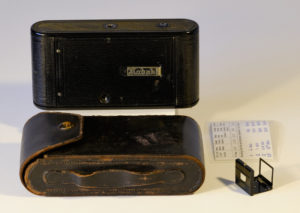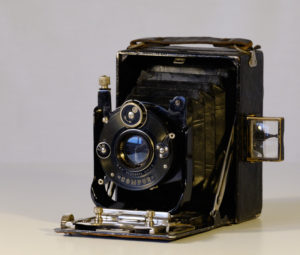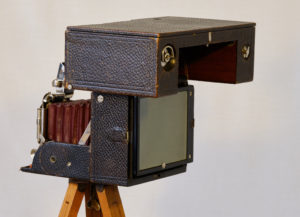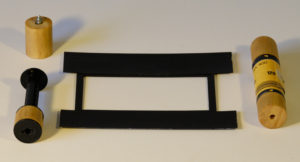Digital has made our processing so much easier and faster, but there is still a place for film for those with the enthusiasm to give it a go. The easiest path is to send the negatives out for processing and the scan and digitise the result. You don’t need a high quality scanner to get great results, but you do need to be sure the scanner has a film holder or that you can make one.
Developing colour film oneself is not an easy option, but black and white is a breeze. The equipment is not expensive.
 I’ve been using a tank that takes both 35mm and 120 film. 120 film is still available and there are many old cameras that take it. Old cameras are more interesting and challenging to use (and often cheaper to buy), and have a look not reproducible in digital.
I’ve been using a tank that takes both 35mm and 120 film. 120 film is still available and there are many old cameras that take it. Old cameras are more interesting and challenging to use (and often cheaper to buy), and have a look not reproducible in digital.
The first camera I bought was a Kodak No. 1 Autographic Special 
Kodak No. 1 Autographic Special Circa 1916
Shutter: Wollensak Optimo No. 1
Lens: Bausch & Lomb Anastigmat No.1
Film Type: 120 Roll Film
Accessories:
 Leather travel case and sight (taken from a later model. I tape this to the body. My eyes aren’t sharp enough to see accurately enough through the original viewfinder I had the shutter calibrated and made up a card listing the actual shutter speeds on one side and the “sunny f/16” rule on the other.
Leather travel case and sight (taken from a later model. I tape this to the body. My eyes aren’t sharp enough to see accurately enough through the original viewfinder I had the shutter calibrated and made up a card listing the actual shutter speeds on one side and the “sunny f/16” rule on the other.
A lovely camera that works beautifully “out of the box”.
Shortly after I added a Thornton-Pickard Imperial Pocket Camera
 Thornton-Pickard Imperial Pocket Camera circa 1911
Thornton-Pickard Imperial Pocket Camera circa 1911
Shutter: Compur
Lens: T.-P. Cooke Anastigmat
Not as simple to use as the Kodak. It’s a dual back camera, with one back taking 120 roll film and the other quarter plates with a folding focussing screen
and the other quarter plates with a folding focussing screen
 It also came with a quarter plate developing tank
It also came with a quarter plate developing tank Pointless for me as I’m never going to go that far with a hobby.
Pointless for me as I’m never going to go that far with a hobby.
I took both cameras to the Antarctic in 2011 and came back with enough images for an exhibition.
It was fun then to explore adapting cameras using other film sizes than 120, so I bought a No. 4 Screen Focus Kodak (two of them in fact) Serial number 586
Serial number 586
Lens and shutter Eastman Kodak
This is a weird one. The No.4 Screen Focus Kodak was introduced in 1904, had a rising and sliding front. Approximately 4,000 were made.
It is a remarkable construction that allowed the roll film back to be swung out of the way allowing the option of using a ground glass for focusing while rollfilm was still in the camera A dark slide was used to protect the rollfilm when ground glass focusing was used. The ground glass frame and dark slide were stored in the rollfilm back when not used. It took 123 film, now long gone.
A dark slide was used to protect the rollfilm when ground glass focusing was used. The ground glass frame and dark slide were stored in the rollfilm back when not used. It took 123 film, now long gone.
Apparently shims are available for most antique cameras to convert them to 120 film. You also need a mask so the film has something to sit on as it’s exposed. However it is really easy to make your own:
 I think the images I made with this camera were really quite beautiful.
I think the images I made with this camera were really quite beautiful.
I’ve had a lot of fun with them but now I’m too busy with assignments and they are sitting in a cupboard, so they are going to eBay. I’m no longer willing to have dust gatherers in the house, not matter how lovely.